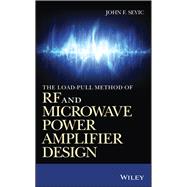Using the load-pull method for RF and microwave power amplifier design
This new book on RF power amplifier design, by industry expert Dr. John F. Sevic, provides comprehensive treatment of RF PA design using the load-pull method, the most widely used and successful method of design. Intended for the newcomer to load-pull, or the seasoned expert, the book presents a systematic method of generation of load-pull contour data, and matching network design, to rapidly produce a RF PA with first-pass success. The method is suitable from HF to millimeter-wave bands, discrete or integrated, and for high-power applications. Those engaged in design or fundamental research will find this book useful, as will the student new to RF and interested in PA design.
The author presents a complete pedagogical methodology for RF PA design, starting with treatment of automated contour generation to identify optimum transistor performance with constant source power load-pull. Advanced methods of contour generation for simultaneous optimization of many variables, such as power, efficiency, and linearity are next presented. This is followed by treatment of optimum impedance identification using contour data to address specific objectives, such as optimum efficiency for a given linearity over a specific bandwidth. The final chapter presents a load-pull specific treatment of matching network design using load-pull contour data, applicable to both single-stage and multi-stage PA's. Both lumped and distributed matching network synthesis methods are described, with several worked matching network examples.
Readers will see a description of a powerful and accessible method that spans multiple RF PA disciplines, including 5G base-station and mobile applications, as well as sat-com and military applications; load-pull with CAD systems is also included. They will review information presented through a practical, hands-on perspective. The book:
- Helps engineers develop systematic, accurate, and repeatable approach to RF PA design
- Provides in-depth coverage of using the load-pull method for first-pass design success
- Offers 150 illustrations and six case studies for greater comprehension of topics









